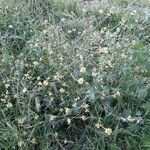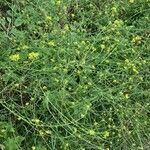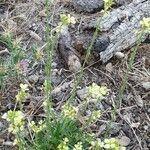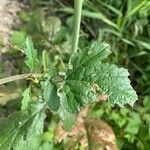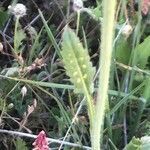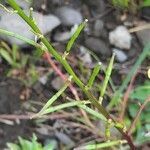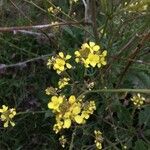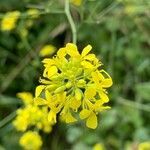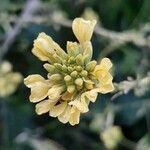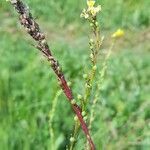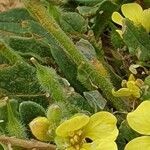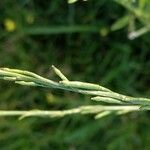Annual herb. Stems weakly ribbed, bearing slightly deflexed short tapered hairs, but ± glabrous above, and below with age, (10)-20-60-(80) cm tall. Lvs serrate to dentate, petiolate, hairy with short tapered hairs. Lower lvs pinnate to pinnatifid or rarely not lobed, (2)-8-20 × (1)-2-7 cm, with a large ovate-oblong terminal lobe and (0)-1-4 pairs of oblong lateral lobes. Upper lvs ovate to linear, 2-5 × 0.5-1.5 cm. Racemes glabrous or hairy, 10-30-(40) cm long. Pedicels erect, 2-4 mm long. Sepals narrow-lanceolate. Petals pale yellow with darker veins, 6-10 mm long; limb elliptic. Silicle erect, hairy or glabrous, weakly to strongly ribbed and rugose; lower segment cylindric or barrel-shaped, 2-3-(5) mm long; upper segment ovoid to turbinate, 2-4 × 2-4-(5) mm, tapering ± abruptly above; style 2-3 mm long. Upper seed c. 2 mm long, lower c. 1 mm long.
Annual or biennial herb, erect, 15–60 (occasionally to 90) cm high, branched, somewhat glaucous, hispid. Lower leaves lyrate-pinnatifid, petiolate, to 25 cm long, the terminal lobe large, laterals usually of 3 pairs; margins irregular to coarsely dentate; cauline leaves reducing. Sepals 2.5–3 mm long. Petals 5–10 mm long, yellow, dark-veined. Silicula 5–10 mm long, indehiscent, articulating between the two dimorphic segments, erect to slightly spreading on pedicels 2–5 (sometimes to 10) mm long; lower segment cylindrical, striate, 2.5–3.5 mm long, 1.5 mm wide; upper segment 3–6 mm long, 3–4 mm wide, rugose, ribbed, sometimes hispid, beak narrow, conical 1–3 mm long. Seeds dimorphic; upper seed ovoid, c. 2 mm diam.; lower seed smaller, aborted or absent.
Plants hispid proximally, glabrous distally. Stems (1-) 2-10(-15) dm. Basal leaves: petiole 1-5 cm; blade with 1-5 lobes each side, 2-25 cm, margins irregularly dentate, lateral lobe oblong or ovate, terminal lobe suborbicular or ovate, larger than lateral. Cauline leaves: blade simple or sinuately lobed, margins subentire or dentate. Fruiting pedicels erect, (appressed to rachis), 1.5-5 mm. Flowers: sepals 2.5-5 mm; petals pale yellow, 6-11 × 2.5-4 mm; filaments 4-7 mm; anthers 1.2-1.5 mm. Fruits: valvular segment ellipsoid, 0.7-3 × 0.5-1.5 mm; terminal segment globose or ovoid, 1.5-3.5 × 1-2.8 mm, usually rugose or ribbed, rarely smooth; style 1-3(-5) mm. Seeds 1.5-2.5 mm. 2n = 16.
Annual herb, 0.35-1.00 m high, branched from base. Stems retrorsely hispid near base, glabrescent above. Leaves: basal leaves petiolate, lyrate-pinnatipartite, 2-or 3-jugate, lateral lobes ovate-triangular, obtuse, incise-dentate, terminal lobes ovate, coarsely dentate, hispid; upper leaves petiolate, lanceolate, cuneate, margins dentate or subentire; all leaves sparsely puberulous or upper surface glabrous. Inflorescence a raceme. Petals clawed, pale yellow. Fruit a siliqua, pedicellate, smooth or ribbed, glabrous or hairy, 1-seeded.
A cabbage family herb. It is a plant which re-grows each year from seed or can take 2 years to complete its life cycle. It grows about 1 m high. The plant is branched. It has stiff hairs. The leaves near the base form a ring and have leaf stalks. These leaves are lobed and have irregular teeth along the edge. The flowers are yellow. The petals have easy to see dark veins. The fruit have 2 segments. One is thin and the other is rounded. There is a beak at the end.
Annual, 2–10 dm, hispid at least below; lvs mostly basal, oblanceolate to obovate, pinnatifid to coarsely dentate; cauline lvs few, smaller, merely dentate; pet 6–10 mm; mature pedicels stout, erect, 2–4 mm; lower member of the fr 2–3 mm, upper member 3–4 mm; beak 1–4 mm; 2n=16. Native of Eurasia, rarely adventive in waste places with us. All summer.
Annual herb, up to 0.8 m high. Upper segment of fruit globose or ovoid, beaked with persistent style. Flowers pale yellow.
